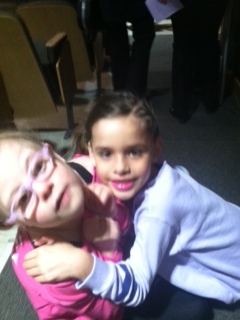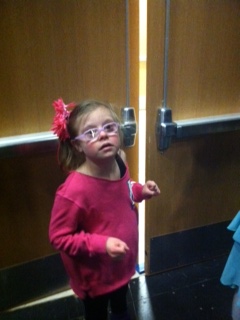This Is Inclusion
Last week, Jo Jo performed in the school variety show with three of her friends. I had no idea what to expect. I really, really didn’t. It started out innocently enough: I got a school flyer announcing the variety show, I texted the mom of one of Jo Jo’s best friends, Lily, she suggested I email the moms of all the other little girls in the class to see who wanted to do a dance routine with us.
Two other kids joined. We brainstormed on themes. I suggested Flashdance; if nothing else the girls could hop around in cute little leotards and leg warmers. All the other moms enthusiastically agreed (hey, we all grew up in the 1980s).
We held several meetings/playdates to “choreograph” the dance. Between veggie sticks and Barbie dolls, the girls brainstormed their moves. Jo Jo refused to join in. She sat on the couch, waving her Elsa doll like a conductor waving a baton, watching her friends.
It stung. Here I was, doing something I’d always dreamed and expected to do with my daughter—designing a dance routine for her first grade talent show—and she couldn’t participate. Or really, maybe it was a wouldn’t. I honestly didn’t know. Was it hard for her due to her low muscle tone and lack of coordination? Or was it simply stubbornness?
The other moms looked at me quizzically. “Let her be,” I said, with more confidence than I felt. “I think she’ll be different when she’s actually on stage.” Last fall, I’d signed Jo Jo up for an adaptive dance program in Milford, where she’d learned ballet with other children with disabilities. For most of the classes, she sat on the sidelines and refused to move, but when show time actually came—a Nutcracker performance with members of the New England Ballet—she got right up on stage and followed along with the rest of the kids.
Sure enough, when the dress rehearsal came, Jo Jo unleashed a slew of her premier danseur moves. She was more than game to follow the lead of her friends. Trouble was, she didn’t quite get some of the niceties of the routine. Like she was supposed to dance NEXT to the girls in a straight line, not facing right in front of them. Or that she was supposed to move OUT of the way when Lily did her cartwheel or Leila did her pirouettes. There were her three little first grade fellow dancers, earnestly linking hands and doing a kick line, while Jo Jo flapped and thumped around like a drunken Rockette.
We all agreed that now Jo Jo was back in the mix, we needed to schedule another practice. Problem was, when we gathered to rehearse, Jo Jo reverted back to her old ways. Nothing—her favorite fruit snacks, her Elsa doll, even some glittery hot pink scarves—could convince her to join the other girls. Forget it, her expression clearly said. If it’s not the big time, I’m not wasting my time.
I was ready to give up. As much as I wanted to see Jo Jo in the variety show, I worried she was too much of a loose cannon to perform. Images of her careening off the stage as the other girls dutifully leapt to “What A Feeling” invaded my brain. But my friend Carolyn (Lily’s mom) stepped in. “Next thing I knew, she was on “stage”. “Pretend I’m Jo Jo,” she told Lily, Leila and Sidrah, who all looked at her as if she was nuts. Undaunted, she took her place with them, squatting down to their height and twirling around. I was impressed, not only by her knee strength but by her perseverance. I was about to give up and it was my kid.
Every time they did a new move, she just stood there, and when they moved uncertainly around her she stopped them and said, “I’m Jo Jo. What do you do next?”
The first few times, they just stopped and hesitated like little baby deer caught in headlights. Finally, someone would chirp, “bring you in!” and they’d grab Carolyn’s arm and guide her through the routine. Carolyn had them repeat it, again and again. Each time, there was a little less hesitancy as they reached for her arm and brought her in. By the end, they were doing it instinctively, you could tell. It looked natural, not forced.
“Thank you,” I said simply to Carolyn when they were finished. It was one of those times where there was so much to say there was almost nothing to say. She’d done in fifteen minutes what it had taken disability rights activists more than fifty years to achieve.
She shrugged. “No problem,” she said casually.
The next evening everyone showed up to the variety show in their favorite Flashdance-esque finery, which included cut up Hello Kitty sweatshirts, leg warmers, huge side ponytails, and eye shadow and lip gloss. The girls were eager to help Jo Jo practice her moves, and they pulled her over to the side, arms wrapped around her and giggling.
I shepherded everyone backstage, where they had the four girls sit on seats waiting for their turn.
I noticed Jo Jo was trembling. Whether it was from cold, or stage fright, or just uncertainty at all the bright lights and people, I didn’t know. I was about to go over to her when her friend Leila reached over and grabbed her hand. “It’s okay, Jo Jo,” she said, and as the backstage techs motioned the girls up to walk on stage I watched as she gently guided my daughter out, without me.
They performed. And they rocked it.
[embed]https://www.youtube.com/watch?v=eKJgYcqH2Nc&feature=share[/embed]
When you have a child with a disability, you’re bombarded with information about inclusion. Words like the Individuals with Disabilities Education Act (IDEA) and Least Restrictive Environment (LRE) and Free Appropriate Public Education (FAPE) are bandied around like canapes at a cocktail party.
But inclusion is so much more than following the letter of the law, or making sure your child spends at least 80% of their day in the regular education classroom. It’s a philosophy, a way of life, a feeling. It’s watching your daughter dance with her friends in matching Hello Kitty sweatshirts, holding hands and giggling. It’s knowing that your daughter’s with a group of girls who know she has a disability, and are sensitive to it, but at the end of the day just want her to participate, no matter her limitations.
And it’s knowing that when she needs it, they give her a hand, not condescendingly, but as equals.
They music faded. The audience went wild. The girls started to skip off stage and then remembered to take a bow. Jo Jo still stood in the center of the stage, uncertain but dutifully clapping her hands and cheering.
I wondered if I’d have to go on stage to retrieve her. But before I could move, I saw Lily skip over to her as the curtain dropped and I heard her yell, “Jo Jo, we did it!”
Leila and Sidrah raced over, and for a moment all four were huddled in a mass, jumping up and down and laughing. Then they all bounded through the curtain into the depths of the backstage. I watched four little ponytails disappear, knowing that I didn’t need to rush after them to check on my daughter. Her friends would make sure she was okay.



